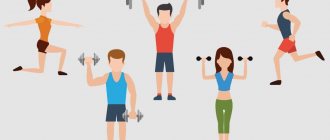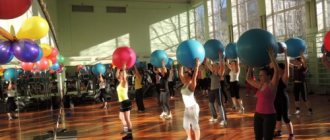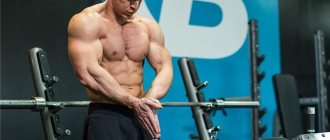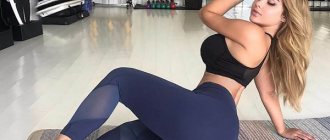What do jumping give?
In strength sports, the development of the fastest possible muscle contraction is used in squats, deadlifts, as well as clean and jerks. Therefore, jump squats are a combination of two exercises that increase each other’s effectiveness and contribute to progression in weightlifting and powerlifting. The main goal of the exercise is to give a more powerful impulse at the bottom or “dead” point of the movement, which allows you to perform the element with high quality while observing the technique.
In fitness, jumping is used in two main variations.
- When working with heavy weights to improve working weights in squats.
- Also, half squat jumps (with knees at a right angle or higher) without weight are one of the most popular movements for HIIT and bodyweight supersets.
Jump Squat Variations
- In addition to the classic jump up, advanced athletes perform squats with a side jump. This option requires increased control over the position of the body in space.
- If you want to make the task more challenging, use weights such as dumbbells.
- Also, you can try not just jumping, but jumping onto a small elevation.
- Experienced athletes use so-called “ligaments”: they do a squat, touching their palms to the floor, suddenly take a lying position, do push-ups, return to a squat, and jump.
The choice of variation, of course, depends on the athlete’s level of training. To begin with, it is recommended to master the classic version with jumping up. As soon as you realize that this load is not enough, feel free to move on to complication. Follow your technique and don’t forget about soft and comfortable sneakers!
What muscles work
When jumping from a low seat, the main load falls on:
- Quadriceps.
- Gluteus major.
- Adductor muscles of the thigh.
- Calf muscles.
The core and back muscles also work in static mode.
Execution technique
Jumping out of a full squat is a complex exercise that requires full adherence to technique. This is especially true for the landing phase, which is considered the most traumatic if performed incorrectly.
Jumping technique:
- Take a jumping position, the starting point is in a sitting position. Try to squat as low as possible while keeping your back straight (hips below parallel to the floor).
- Keep your hands near your chest in a free position, the body is tilted forward so that the pelvis does not tuck inward and is pulled back.
- Make a powerful push from your heels, stand up and, using the given inertia, make a jump to the maximum height.
- During the jump, the arms are straightened at the elbow and moved back slightly to maintain balance in the air.
- Land softly on your toes, squat below the parallel of your thighs with the floor and jump again from a low position.
It is extremely important to do the jumps on a soft surface. This applies to both beginners and professionals, who can easily jump onto a stand as tall as they are. The soft surface does not return momentum upon landing and “quenches” inertia, which allows you to maintain healthy joints and spine. Therefore, try to do squat jumps on the ground, mats or any other non-hard surface.
Jumping options with weights
In fact, you can do jumping jumps while crouching in a deep position with any type of weights. However, dumbbells, barbell plates and kettlebells are considered the most convenient. Also in some gyms they practice jumping out of a squat together with a barbell, although due to the length of the bar this option is considered not the most convenient (available only in spacious halls where there is enough space to perform the element).
The basic technique of movement does not change depending on the projectile used. The main differences relate to the way the arms work and the upper body supports the weight. Also, significantly more stress is placed on the arms, shoulders and back when working with weights.
Jumping technique with dumbbells
Dumbbells are the easiest option.
- At the starting point, the arms are slightly bent and located near the hips.
- During the jump, the arms are straightened, the weight is kept on the relaxed limbs.
Jumping with a weight plate
Barbell plate – the most convenient option is to press the plate to your chest. Hug it with your arms crosswise, this will help securely fix the projectile and not distort the technique.
Barbell Squat Jumps
Barbell – Secure a barbell across the back of your shoulders, just like you would for a squat. Frontal holding of the bar is also allowed, but in this case a greater load will be placed on the abdominal muscles, which can “lead” the athlete forward and lead to loss of balance.
Jumping with a sandbag
Sandbag – Hold the bag in a bear hug in front of you, or place it on the back of your shoulders, just below your neck. The bag is more convenient because, unlike a barbell, it is streamlined and more compact. Allows you to work with heavy weights. More about sandbags →
also important to remember that squat jumps should not be done with heavy weight. With this technique, the body gains less inertia and the joints are loaded much more heavily. Also, this technique does not lead to a pronounced development of explosive power in the quadriceps to the same extent as jumping out of a deep squat.
Contraindications
You cannot do jump squats in the following cases:
- for leg injuries, especially knee joints;
- for hypertension and tachycardia;
- pathological changes in the spine, such as hernia or protrusion.
When performing squat jumps, it is important to remember that the higher you jump up, the greater the effect of the exercise. Don’t forget about the correct technique and contraindications, and your workouts won’t end with injuries, but will help you work out your muscular frame, pump up your buttocks and thighs, and develop endurance.
In terms of effectiveness, such jumps can be compared with front squats with a barbell, and in some ways even better. The jumping squat exercise can be done both at home and in the gym. The effect of the exercise is impressive, so jump squats are gaining more and more popularity not only among professional athletes, but among those who simply want to lose weight and get a sculpted and beautiful body.
Training Recommendations
- Never start lifting weights. First, you need to completely master and learn the entire sequence of actions when performing jumping, and then move on to working with minimal weights. This way your ligaments, muscles and joints will be ready for gradually increasing loads.
- To perform jumps without consequences, the lower leg muscles must be sufficiently developed. A soft landing on your toes depends on them. Never rest on your heels or your entire foot.
- Do not perform low squat jumps with squats. To increase efficiency, it is better to divide these exercises into different training sessions.
- To train for maximum explosion, do not do long series of jumps. The greatest effectiveness is shown by single jumps with a rest of 10-15 seconds. When working without weights, the exercise can be done in series of 5-10 repetitions.
- Before starting a workout, always do a complete warm-up of your entire body, from neck to heels. Despite the fact that the main load falls on the lower body, insufficiently warmed back muscles can lead to increased compressive load on the spine.
Benefits of Exercise
Improves technique
One of the best things about box squats is that the lifter always has to lower the pelvis below the knees (over parallel) in order to reach the box during the eccentric phase of the exercise. When an athlete performs simple squats, there is a tendency to squat less deeply depending on the weight (the higher the weight, the shallower the squat).
Box squats allow you to completely overcome this problem and after consistent practice with box squats, the athlete will always drop below knee level. Moreover, box squats allow you to improve your technique in the sense that the athlete will always perform a full squat when lowering, and will not just fall down and spring back up. However, springing can also be an advantage, as I will discuss below.
Improves stretching and range of motion
Box squats can be classified as ballistic stretching exercises. This exercise can be very helpful for people with poor stretching and range of motion and makes it easy to measure your progress in this area.
If an athlete cannot lower the pelvis below knee level when performing squats, then simply place the box so that its height is greater. If this is not enough, then you can put a 20 kg barbell plate on it (if necessary, several). As the athlete develops his flexibility in the squat, you can gradually remove the weights and then lower the height of the box until it is below parallel (the height at which you have to lower your pelvis below your knees to sit on the box).
Helps develop strength and power
As I noted, box squats force the athlete to squat backwards rather than simply downwards. This allows the lifter to sit further on the box and achieve a perpendicular (or further greater) angle between the shin and the floor. As a result, he receives a huge load on the gluteal muscles and lower back muscles.
Moreover, since the box squat forces the athlete to overcome the eccentric-concentric relationship, the result is that he develops enormous strength by learning to overcome the concentric phase of the exercise. In addition, at the same time, muscles are used at full strength, which a few seconds before were completely relaxed due to the fact that the athlete was sitting on a box, and not hanging in the air, as with conventional squats.
Yes, springing a standard squat can be helpful and allows you to lift from the bottom of a squat, but if you can lift a ton from a box sit position, there's no doubt you can lift the same weight (or more) with simple squats . In fact, box squats require an athlete to generate three to four times more force than any other type of squat!
Safer
When you're doing standard squats and you lose your balance, the thought arises of twisting your elbows out from under the bar and letting it fall behind you. Of course, not every athlete can correctly cope with the problems that may arise during the performance of squats (loss of balance, too much weight, etc.), and if your legs begin to shake when you are at the bottom of the squat, get out of this the situation will be difficult, even if you are an experienced athlete.
If the weight turns out to be too heavy when performing a box squat, then you have insurance in the form of this very box behind you. If you can’t get up, just call your spotters and they will help you get up. Fortunately, this won't be a big problem because when you do box squats, you use less weight and have to do everything in a better stance, which allows you to reduce the pressure on your back. Finally, the perpendicular angle between the shin and the floor reduces the stress on the kneecap, making this type of squat much more gentle on the knees.










